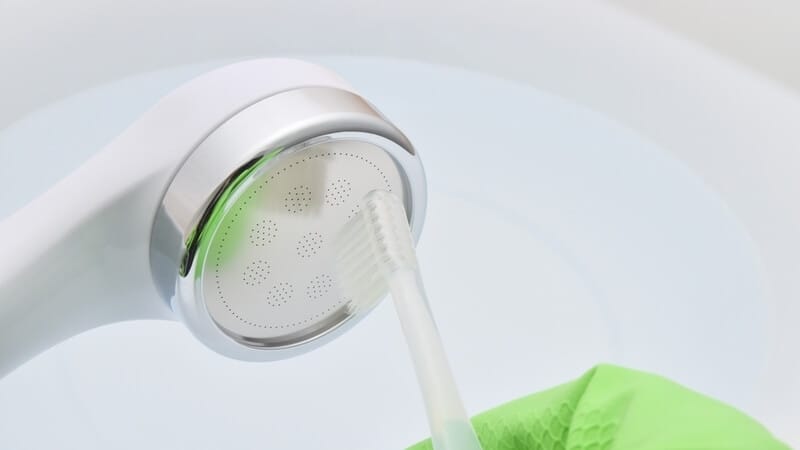It can feel so good to stand under a hot shower after a long day and let the water wash off all your stress.
However, you’re probably not thinking about how to wash the shower head itself.
You might be surprised (and horrified) and how much and how easily dirt and mineral deposits can build up on the surface and spray holes/nozzles.
How to clean a shower head? You can do it two ways: without removing the fixture, and with taking it off the arm.
Then you can clean shower heads using:
You can’t hold that shower concert or receive that shower Oscar if your water is a sad trickle. So get cleaning – and best of all, most of this stuff is already in your home!
Why Clean Your Shower Head?
The shower head just sprays water, so it should be fine, right? Nope!
Mineral deposits, soap scum, and other dirt will build up over time. This is especially true if you live in a hard water area.
You can identify minerals like calcium deposits by crusty, white dirt around the surfaces.
The mineral buildup will clog the spray holes, leading to uneven water pressure. A dirty shower head can also lead to mould, mildew, and bacterial growth – which are all health hazards.
Plus, it’s likely the shower is raining dirty water on you… which would defeat the point of your bath.

How Often to Clean a Shower Head
You can do a vinegar soak or a quick scrub for your shower head once a week – make it part of your routine when you clean the shower.
It’s best to deep clean your shower head once a month. If you live in an area with hard water, you may want to clean more often.
Before Cleaning a Shower Head
Do a quick assessment of “how bad” the problem is. Point the shower head away from you and turn it on high.
If the water flow from the nozzles is normal, then you can do a simple clean. However, if the water seems blocked – say, some nozzles aren’t working or the water flow is low – you’ll need to do a deep clean.
(Alternatively, book a house cleaning service to take care of your whole bathroom.)
If you’ll be removing the head from the shower arm, look into shutting off the water supply first so you don’t accidentally flood your bathroom.
And of course, make sure no one needs to shower first!

How to Clean a Shower Head Without Removing It
There are several materials or finishes for shower heads. Plastic is the most affordable and common, as it’s easy to clean.
Chrome is also a typical finish, as it’s affordable and durable. However, it does pick up hard water stains and scuffs easily.
Meanwhile, nickel-coated shower heads are gaining popularity thanks to their classy, matte look. Nickel is more resistant to mineral deposits and water spots, but it can be pricier.
Cleaning a shower head with white vinegar

This is most people’s go-to for everyday or regular cleaning. It’s best for plastic and chrome heads. Avoid it for nickel-plated fixtures, especially if there’s copper underneath.
If you have brass or oiled bronze fixtures, do not let them soak in the solution for more than an hour.
Vinegar will also help kill any mould in or on the fixture.
How to clean a shower head with vinegar? You’ll need:
- Distilled white vinegar
- A plastic bag
- Rubber band or twist tie
- Old toothbrush or toothpick (optional)
Fill the plastic bag with enough vinegar to cover the shower head. (Only just enough, or the bag will overflow.)
Take that vinegar-filled bag and place it over the shower head so the whole fixture is completely submerged. Tie the bag onto the shower arm with the rubber band or twist tie.
(Pro tip: Wait a few moments to see if the bag slips. You don’t want a vinegar water balloon going off in the shower.)
Leave the vinegar soak for a few hours – or, for very dirty fixtures, soak the showerhead overnight. After everyone’s done cleaning up.
This step is optional, but you can use a toothbrush to scrub the nozzles and other crevices. Or use a toothpick to pick out any calcium deposits and loose debris.
Untie the bag and dispose of the contents. Run some hot water for a minute or two to flush out any remaining debris.
Use a soft cloth to polish the fixture afterwards.
NOTE: You use apple cider vinegar instead, but know that it won’t be as effective and it’s more expensive.
Cleaning a shower head with lemon juice
How to clean a shower head without vinegar? Try some lemon juice. It’s also acidic, so this will also dissolve mineral deposits.
But if you don’t want to waste a bunch of lemons to fill up a plastic bag, you can try a paste instead!
Take the shower head off its holder – you don’t need to dismantle it. Then mix a few tablespoons of lemon juice with some baking soda to make a paste.
Use a toothbrush to apply the paste to the shower head and scrub the fixture. Get into all the nozzles and crevices to clean mineral deposits and soap scum.
If you can easily unscrew the cover, take it off so you can scrub the interior as well.
Rinse the shower head with clean water, then turn it on. Let hot water run for a minute or two to remove any residue.
Cleaning a shower head with baking soda

This is another way to clean your shower head without vinegar. It’s best for nickel-coated shower heads, since it’s gentler and non-acidic.
First, though, try washing the shower head with dish detergent and water. Sometimes that’s enough to remove water spots and light mineral buildup.
If that doesn’t work, make a thin paste of baking soda, dish detergent, and water. Use a microfibre cloth to apply the paste onto the shower head and scrub lightly.
For the nozzles, use a toothpick to “scrape” out any stubborn buildup.
Rinse off any residue with clear water, then turn on the shower and run hot water to flush out any remaining debris. Polish and dry the shower head with a clean microfiber cloth.
Commercial cleaner
If you feel the more natural methods aren’t as effective, try a commercial cleaner.
Some great options include CLR Calcium, Lime, & Rust Remover or Durgol Descaler (yes, the one for your coffee machine).
Follow package instructions to make sure you don’t damage your fixtures. For Durgol, you can soak the shower head in diluted product for up to 30 minutes, then rinse with clean water.
How to Deep Clean a Shower Head
Sometimes, the mineral deposits are just too stubborn. And of course, it’s important to do a thorough cleaning once a month.
Disconnecting your shower head

To deep clean the shower head, you will need to disconnect the fixture.
Cover the nut with a rag, then use a wrench or lockable pliers to unscrew the fixture.
If you want to take off the shower head without tools, tightly wrap a cloth around the fixture to give yourself good traction.
Firmly grasp the shower head and start twisting counterclockwise. Apply steady and even pressure until the fixture comes loose.
Deep cleaning the shower head

Start by flushing the shower head under a strong stream of water. This will rinse out loose debris. If there are clogs, go in there with some needle-nose pliers.
Dismantle your shower head by unscrewing the cover and removing the filter screen if possible. Set the screen aside.
Add a few drops of dish detergent to some distilled white vinegar. Take a toothbrush dipped in the vinegar solution and use it to scrub the shower head cover and other parts.
Poke out any remaining mineral deposits with a toothpick.
Rinse the shower head thoroughly before reassembling it. Then turn on the hot water for a minute to flush out the remaining dirt.
Wrap some plumbing tape before you reattach the shower head. This will ensure a good seal and minimize leaks.
Deep cleaning the shower filter screen
If your shower head has a removable filter screen, take it out of the nozzle.
Mix equal parts white vinegar and water. You can either soak the filter screen in the solution, or dip a toothbrush into the mixture and scrub the filter.
Be careful so you don’t widen the gaps in the filter or break the mesh.
Rinse the filter screen in clean water and wipe it dry. Place the filter back into the shower head.
NOTE: It’s best practice to buy a new shower filter screen once a year.
Deep cleaning the shower hose or pipe
Take a little time to use that toothbrush dipped in dish detergent and vinegar to clean the shower arm.
Scrub the exterior and as far into the arm interior as you can reach.
Don’t worry – once you’ve reattached the shower head and run some hot water, that’ll rinse out the inside of the arm.
How to Descale a Shower Head

Descaling means removing limescale on the shower head – such as calcium buildup from hard water.
You can descale your shower head with a vinegar soak, or commercial descalers like CLR.
Be sure to follow instructions and work in a well-ventilated area.
How to Remove Rust from a Shower Head
If your shower head is made of metal, prolonged contact with water could cause rust. That rust will flake off whenever you bathe and could get on your shower curtain, shower glass, or tub.
To get rid of the rust, try:
- Spraying with WD-40 and scrubbing with a soft-bristled brush
- Soaking the fixture in vinegar for several hours
- Using a sponge or toothbrush to scrub the rust off with a baking soda paste
Tips for Cleaning Your Shower Head
Avoid using bleach-based products since these could degrade the shower head.
If you want to go the eco-friendly route – especially since you’ll be rinsing stuff down the drain – try a greywater-safe cleaner such as Koala Eco’s Multi-Purpose Bathroom Cleaner.
Work in a well-ventilated area – keep the door and windows open, and switch on the exhaust.
For hard water homes, try installing a water filter or water softener. This will help minimise mineral buildup. You could also opt for an external filter that attaches to the shower hose, like this AquaHome Shower Filter.
And of course, don’t forget to run the shower for a bit before getting under the water – just to make sure everything’s in working order!

